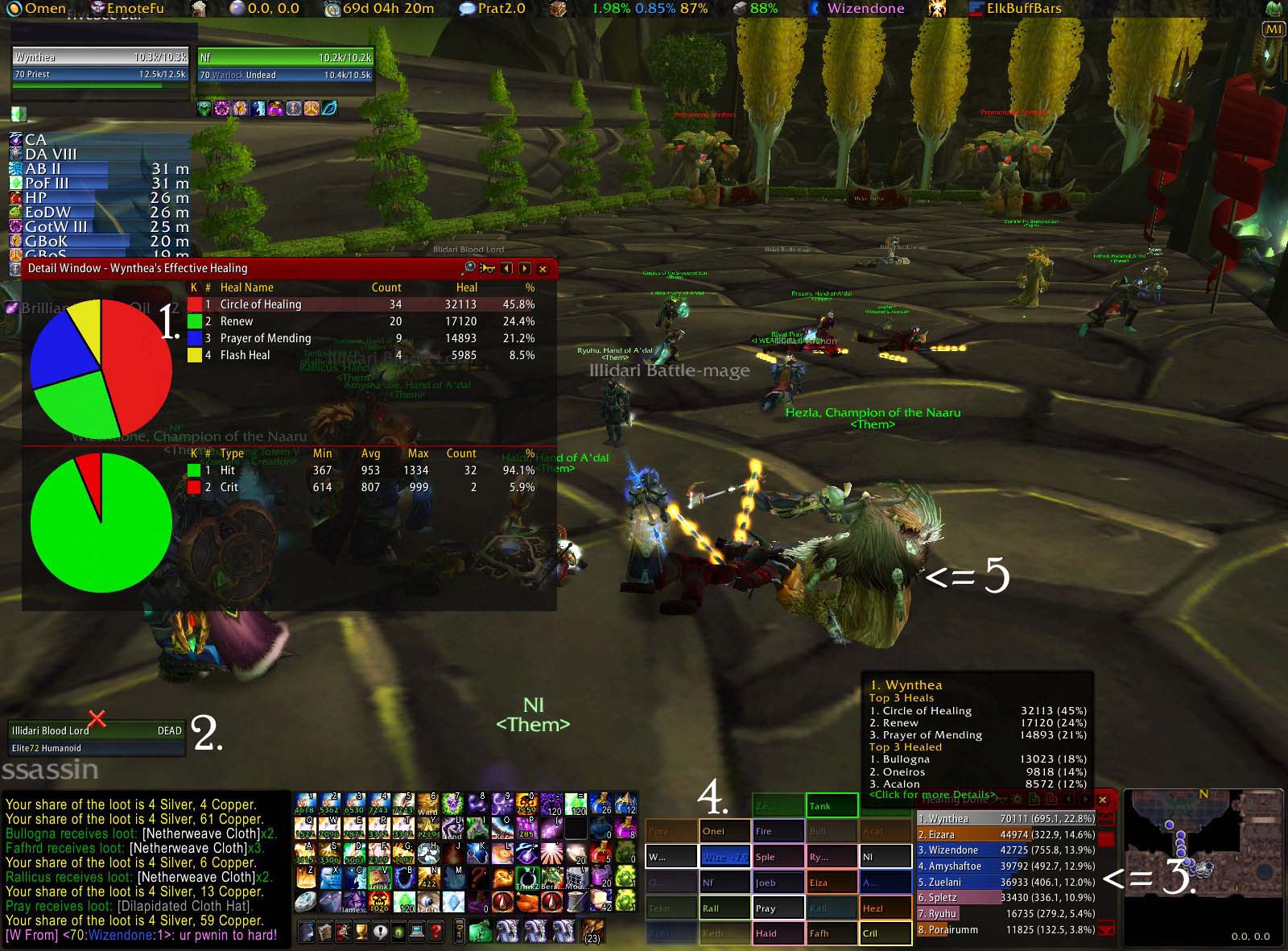Part two of a series. Please read Part One
Note: It seemed more relevant to organize these shots by topic rather than in chronological order. So, we’re jumping from Akama to Illidari Council trash.
Typical Trash Heal Mix:
1. This is pretty typical mix healing on trash. With so much going on, I tend to focus on instant casts. I also use PW:S liberally, but that’s one of few things Recount doesn’t show. I didn’t take an SS of my over-healing, but on trash it’s substantial. My mana-regen is enough that I don’t have to drink between pulls (you can see my mana bar is full). You’ll notice also that I don’t simply spam CoH. It’s overkill, and it’s boring.
2. I have an Illidari Blood Lord set as my focus. This is because he’s a Paladin mob, who will bubble himself and start to heal. The bubble has to be mass-dispelled, so rather than wait for them to call me to dispel it, I just watch him, and cast it as soon as he has the debuff. (around 25-30%.)
3. Recount’s main window. One of the reasons I keep Recount open during combat is to get a good sense of what my fellow healbots are doing. Most of us have been together for a while now, and we have a pretty good idea of our standard baseline. Typically, I’m about 1.5% ahead of Wize, who is around 3% ahead of Eiz, who is about 2% ahead of Por… you get the idea. This is an atypical pull, because Wize is #3. As you can see from Grid, it’s because he got smooshed. (You can’t do your best when you’re dead! remember that!) Also, Por is near the bottom because he was AFK. It’s handy to be able to get a nearly-real-time idea of who’s paying attention to the pull, and who needs to take a break, without having to constantly over-communicate.
The other large reason I keep it open is because my guild is constantly auditioning new healers, and it’s good to be able to give the Raid Leader an accurate opinion of how the new guy is fitting in with the old guard. I also have a pretty good idea of my heal-mates’ gear, and if an under-geared newbie is out-performing a same-class veteran, it will become obvious very fast. With recount, I can see what heals they are casting, who their targets tend to be (tanks, raid, or a combo? do they follow assignments?), and how much over-healing they have. As I’ve said before, over-healing isn’t a huge issue unless people are dying or pulling aggro (then dying), but with a new person, a large amount of over-healing and a low amount of effective heals could indicate a lag problem or a lack of attentiveness. As an additional coaching tactic, I’ll frequently set the trial member as my focus – Quartz allows you to customize those casting bars as well, and I can tell what rank of what heal they’re using, on what target, and at what health level they began their cast. Recount simply makes it easier for me to stalk people, and keeping it open makes the data easier to access. As a side tip, Recount gives you a lot of options for linking the stats. I’ve found that guest healers appreciate getting a quick link to let them know that they’re doing okay. Running with a BT guild on farm can be intimidating, and everyone performs better when they’re relaxed.
I don’t pay a huge amount of attention to recount actually DURING bossfights, I have more to worry about. But I don’t like the idea of opening and closing it all the time any more than I like the idea of not having the trend-style information easily available. And, sometimes, having it up for things like Dispels on RoS phase 1 or Gorefiend helps give real-time feedback to people who need it.
4. With Grid, it’s after the pull, so not much of interest is going on here, but you can see in Wize’s frame what it looks like when someone is highlighted because of low health. Grid also shows exactly what their deficit is, and I have mine set to approximate the amount of incoming heals they’re about to receive. Wize has none incoming, because he just stood up. Again, the faded squares are people who are out of range. You can see the train of people making their way into the Chamber of Command on my mini-map.
5. Yes, we raid with a Battle-Chicken.
